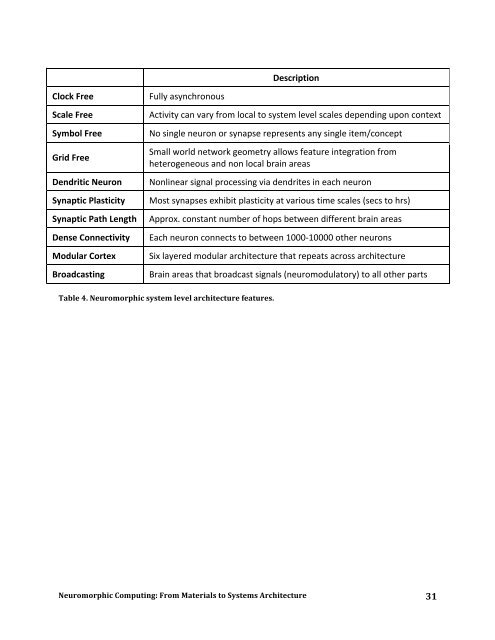Neuromorphic Computing From Materials to Systems Architecture
Neuromorphic-Computing-Report_FNLBLP
Neuromorphic-Computing-Report_FNLBLP
You also want an ePaper? Increase the reach of your titles
YUMPU automatically turns print PDFs into web optimized ePapers that Google loves.
Feature <br />
Description <br />
Clock Free <br />
Scale Free <br />
Symbol Free <br />
Grid Free <br />
Dendritic Neuron <br />
Synaptic Plasticity <br />
Synaptic Path Length <br />
Dense Connectivity <br />
Modular Cortex <br />
Broadcasting <br />
Fully asynchronous <br />
Activity can vary from local <strong>to</strong> system level scales depending upon context <br />
No single neuron or synapse represents any single item/concept <br />
Small world network geometry allows feature integration from <br />
heterogeneous and non local brain areas <br />
Nonlinear signal processing via dendrites in each neuron <br />
Most synapses exhibit plasticity at various time scales (secs <strong>to</strong> hrs) <br />
Approx. constant number of hops between different brain areas <br />
Each neuron connects <strong>to</strong> between 1000-‐10000 other neurons <br />
Six layered modular architecture that repeats across architecture <br />
Brain areas that broadcast signals (neuromodula<strong>to</strong>ry) <strong>to</strong> all other parts <br />
Table 4. <strong>Neuromorphic</strong> system level architecture features.<br />
<strong>Neuromorphic</strong> <strong>Computing</strong>: <strong>From</strong> <strong>Materials</strong> <strong>to</strong> <strong>Systems</strong> <strong>Architecture</strong> <br />
31


